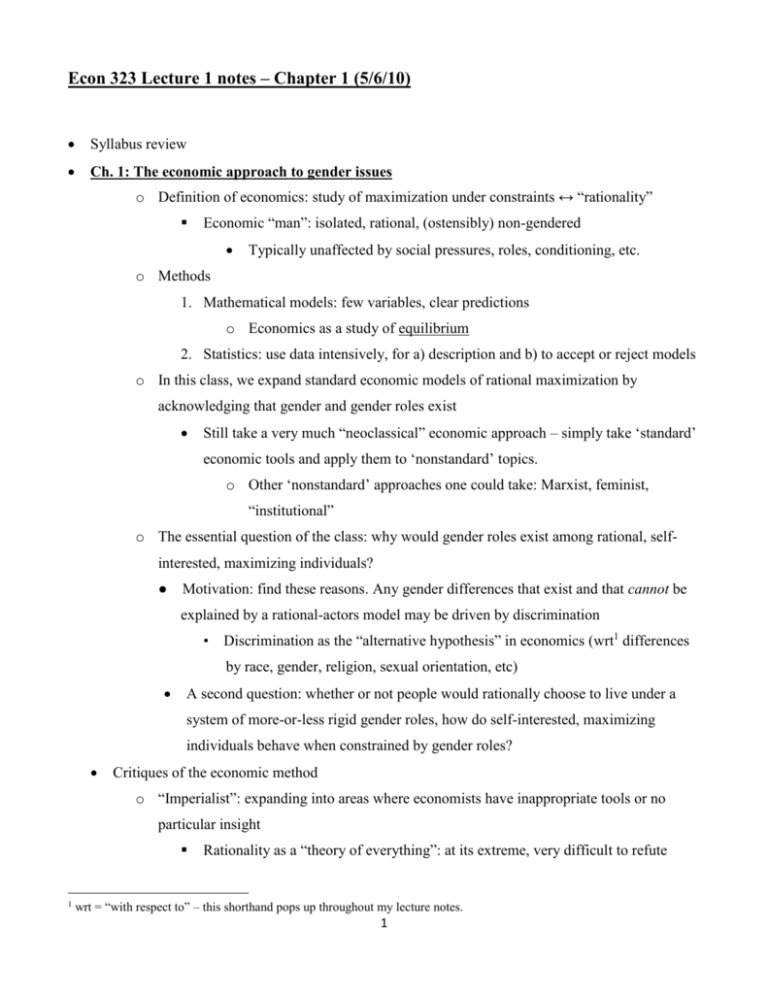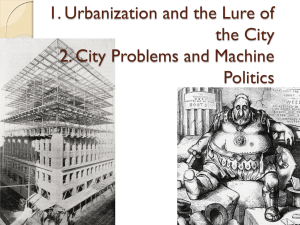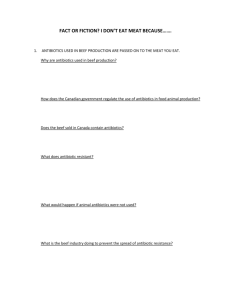Course intro lecture
advertisement

Econ 323 Lecture 1 notes – Chapter 1 (5/6/10) Syllabus review Ch. 1: The economic approach to gender issues o Definition of economics: study of maximization under constraints ↔ “rationality” Economic “man”: isolated, rational, (ostensibly) non-gendered Typically unaffected by social pressures, roles, conditioning, etc. o Methods 1. Mathematical models: few variables, clear predictions o Economics as a study of equilibrium 2. Statistics: use data intensively, for a) description and b) to accept or reject models o In this class, we expand standard economic models of rational maximization by acknowledging that gender and gender roles exist Still take a very much “neoclassical” economic approach – simply take ‘standard’ economic tools and apply them to ‘nonstandard’ topics. o Other ‘nonstandard’ approaches one could take: Marxist, feminist, “institutional” o The essential question of the class: why would gender roles exist among rational, selfinterested, maximizing individuals? ● Motivation: find these reasons. Any gender differences that exist and that cannot be explained by a rational-actors model may be driven by discrimination • Discrimination as the “alternative hypothesis” in economics (wrt1 differences by race, gender, religion, sexual orientation, etc) A second question: whether or not people would rationally choose to live under a system of more-or-less rigid gender roles, how do self-interested, maximizing individuals behave when constrained by gender roles? Critiques of the economic method o “Imperialist”: expanding into areas where economists have inappropriate tools or no particular insight 1 Rationality as a “theory of everything”: at its extreme, very difficult to refute wrt = “with respect to” – this shorthand pops up throughout my lecture notes. 1 o Too simplistic: models easy to understand but miss important underlying phenomenon Non-economic approaches o Biology – gender vs. sex (“nature vs. nurture”) Sociobiology: evolution as the determinant of gender roles o Psychology, anthropology, sociology, political science o Women’s studies and academic feminism maximalist/essentialism vs. minimalist/constructivism o Since my approach and background are largely neoclassical, your voices and experiences from other perspectives and disciplines is very important. Hopefully, we can make this class more discussion-based than you’re used to econ classes being. Microeconomics review: appendix to Ch. 1 (each has an associated graph) o Opportunity cost: the value of the best alternative given up in order to obtain (the value of) some good A way to measure the cost of every good/choice The lower bound of the value of any observed choice; o Supply and Demand Supply: sum of individual willingness to sell, given a price. Demand: sum of individual willingness to buy, given a price. Excess supply and demand as equilibrating forces, pushing towards market clearing P & Q Shifts in curves reflect changes in factors other than price and quantity. Demand shifters: income, preferences, price of consumption substitutes and complements, population, price expectations Supply shifters: input costs, technology, price of productive complements and substitutes, number of firms Special case of particular interest: labor supply and labor demand Reservation wage: minimum willingness-to-supply labor. o Market structure Perfect competition: a market with many buyers and sellers Modeled by supply and demand 2 Surplus maximization Deadweight Loss (DWL): social value foregone due to a regulation/intervention Monopoly: a market with many buyers but only one seller Profit maximization: MR = (MC=S) MR < D o The fact of one market price for the good implies that as the monopolist decreases price at the margin (for the last unit sold), revenue is lost on each unit that would have been sold already DWL Monopsony: a market with many sellers but only one buyer Profit maximization: MC = (MR=D) MC > S o The fact of one market wage for the good implies that as the monopsonist increases wage at the margin (for the last worker hired), costs are increased for each worker than would have been hired already Deadweight loss Effects of price regulation: a minimum wage can reduce DWL in this circumstance! Barriers to entry Monopolists/monoposonists can set prices as they do because they can set prices as they please due to lack of competition Unions, professional organizations (ABA, AMA) and their role in gender inequality by creating barriers to entry o Marginal vs Total Maximizing agents make decisions at the margin Consumption and production, work and leisure, etc Consumption optimization (given prices) at the point where 𝑀𝑈1 𝑀𝑈2 ⁄𝑃 = ⁄𝑃 1 2 for all goods. “Equalize benefits per dollar across all goods”. 3 Indifference curve: all the combinations of two goods that give a certain level of utility/happiness o The proper shape of an indifference curve is always downwardsloping, convex in the presence of diminishing marginal utility. The budget constraint (BC): all the combinations of “stuff” you can obtain, given income o E.g., income = $1000, P1 = $20, P2 = $50 Graphical representation of utility maximization: find the best/highest indifference curve given your budget constraint. o 𝑀𝑈1 𝑀𝑈2 𝑀𝑈1 𝑃 ⁄𝑃 = ⁄𝑃 ⟺ − ⁄𝑀𝑈 = − 1⁄𝑃 ⟺ 1 2 2 2 slope(indifference) = slope(BC) o “The value per dollar of good one must equal the value per dollar of good two” “The tradeoff in utility per good must equal the tradeoff in economic cost” o Trade: comparative advantage in a competitive environment Opportunity cost in the context of a PPF E.g., two countries, both with 100 units of labor o A takes 3 L to make a pepper, 4 L to make beef o B takes 4L to make a pepper, 10 L to make beef A has comparative advantage in beef (1 beef = 4/3 pepper; 1 pepper = 3/4 beef), B has comparative advantage in peppers (1 beef = 2.5 peppers; 1 pepper = 2/5 beef) Optimization in a PPF Specialization and trade at some mutually-agreeable international price, under competition (i.e., after specialization, one more unit of consumption of one good for one country one less for the other) 4






